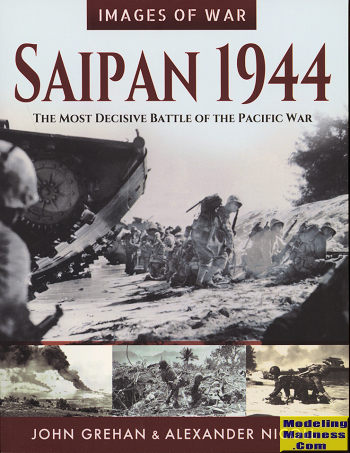 This
addition to the Images of War series concentrates on the invasion of Saipan
during WWII. Saipan was once German territory and after WWI, it was given to
Japan. This meant that it was basically Japanese soil and by the start of the
war, most of its inhabitants were Japanese. It was also an important Japanese
staging ground and held a large Japanese built airfield.
This
addition to the Images of War series concentrates on the invasion of Saipan
during WWII. Saipan was once German territory and after WWI, it was given to
Japan. This meant that it was basically Japanese soil and by the start of the
war, most of its inhabitants were Japanese. It was also an important Japanese
staging ground and held a large Japanese built airfield.
Saipan is the second largest island in the Mariana chain
with Guam, which was a US possession, being the largest. Typical of Pacific
islands, it has a mild and humid climate. In fact, the most moderate temperature
of anywhere in the world is on Saipan, which averages about 80 degrees F year
round. It is also typical of old volcanic islands in that the highlands are
rugged and fairly jagged, making it ideal for defenders.
When planning for the war in the Pacific during 1943,
you had two differing opinions on how to wage the war against Japan. MacArthur,
always the narcissist, wanted to return to the Philippines as soon as possible
so concentrated on the southwest 'land' route. On the Navy side of things, King
wanted to use island invasion to inch closer. This difference in opinion was
changed by the introduction of an airplane; the B-29. Here was a long range
bomber that could reach Japan and return. However, it still needed to get fairly
close, and one good place to base these aircraft was in the Mariana Islands.
Hence, while MacArthur was allowed to slog through the jungles towards the
Philippines, priority was given to King and the conquest of the Marianas in
order to have the bases for the B-29.
Thus the preparations for the invasion of Saipain,
Tinian, and Guam. This book concentrates on Saipan. In line with others in the
series, you are provided an abbreviated history in every chapter along with a
bevy of great period photos. This book differs from others I've recently read in
two ways. One is that the historical section is not alone in the start of each
chapter but helps to fill some 'white space' in the first several chapter pages.
The others are the fair number of images that cross the 'ditch' in the middle of
the book. I know that this is to provide larger images or to take up space when
you don't have enough images. Either way, I'm not a fan of this.
In addition to the story of Saipan, you are provided a
section on the Battle of the Philippine Sea, which was pretty much the death
knell for Japanese naval aviation. I'm sure that Tinian and Guam will be later
volumes. A book well worth picking up and one I know you will enjoy reading.
July 2021
Copyright ModelingMadness.com. All rights reserved.
No reproduction in part of in whole without express permission.
Review book courtesy of
Casemate Publishing, where you can order your copy
at this link.
If you would like your product reviewed fairly and
fairly quickly, please
contact
me or see other details in the
Note to
Contributors.
 This
addition to the Images of War series concentrates on the invasion of Saipan
during WWII. Saipan was once German territory and after WWI, it was given to
Japan. This meant that it was basically Japanese soil and by the start of the
war, most of its inhabitants were Japanese. It was also an important Japanese
staging ground and held a large Japanese built airfield.
This
addition to the Images of War series concentrates on the invasion of Saipan
during WWII. Saipan was once German territory and after WWI, it was given to
Japan. This meant that it was basically Japanese soil and by the start of the
war, most of its inhabitants were Japanese. It was also an important Japanese
staging ground and held a large Japanese built airfield.